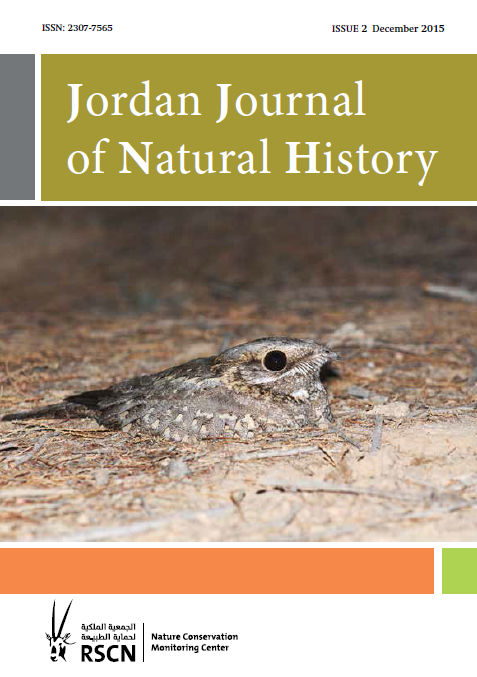Articles
Flora of Shaumari Wildlife Reserve, Jordan
Author Name
Dawud Al-Eisawi & Anas Abu Yahya
Shaumari Wildlife Reserve is the first reserve established by the Royal Society for the Conservation of Nature in Jordan, yet the total flora accounts has never been published or known to the nearest species number. In this study the flora of Shaumari Wildlife Reserve has been prepared and accumulated based on the latest survey and all previous studies since 1975. This study has revealed that the flora is composed of a total number of 237 species belonging to 152 genera and 36 families. All taxa and abbreviations were checked in accordance to the latest Plant List of Plants (Royal Botanic Garden, Kew, UK) and according to the Tropicos database (Missouri Botanical Garden, USA).
Some records of freshwater snail from the Occupied Palestinian territories
Author Name
Elias N. Handal, Zuhair Amr & Mazin B. Qumsiyeh
This study contributes to the taxonomy and distribution of the freshwater snail fauna in the Occupied Palestinian Territories. A total of 10 species offreshwater snails belonging to five families (Neritidae, Melanopsidae, Lymnaeidae, Physidae and Thiaridae) in seven genera (Galba, Haitia, Lymnaea, Melanoides, Melanopsis, Pseudoplotia and Theodoxus) were collected. Melanopsis buccinoidae was the most common species. Theodoxus jordani and Theodoxus macrii were noted mostly around the Jordan River basin.
New records of Jordanian scorpions
Author Name
Zuhair Amr, Omar A. Abed, Thabet Al Share, Nashat Hamidan & Lorenzo Prendini
Fourteen scorpion species were collected during a recent field expedition to Jordan. Family Buthidae was represented by twelve species in seven genera (Androctonus, Birulatus, Buthacus, Compsobuthus, Hottentotta, Leiurus, and Orthochirus) and families Diplocentridae and Scorpionidae by one genus and species each (Nebo and Scorpio) respectively. Buthacus nigroaculeatus and B. yotvatensis were recorded for the first time in Jordan
A revised account of the geographical distribution of the endangered freshwater fish Garra ghorensis in Jordan and implications for conservation
Author Name
Nashat Hamidan & Robert Britton
The spatial distribution of the endangered cyprinid fish Garra ghorensis
was initially assessed through sampling of 6 riverine sites across Jordan in 2002, with a repeat survey completed in 2010 to detect changes in their distribution. In this latter survey, an additional 8 sites were also sampled in an attempt to fully describe their distribution range, although only one more population was recorded. Comparison of the presence/ absence data in the sites sampled in both 2002 and 2010 revealed no changes in this aspect of their distribution. In 2002 survey, their populations co-existed with either native or invasive species, whilst the population detected in 2010 was in allopatry. Between the two survey periods, however, the physical characteristics of the majority sites had altered with, for example, a series of significant water impoundments constructed. These will potentially result in a loss of longitudinal connectivity in these rivers, leasing to habitat and population fragmentation. Although no detrimental effects of these changes were detected in 2010, given the endangered status of G. ghorensis, efforts to minimise potential effects of population fragmentation are recommended.
Ecological study on the Nubian Nightjar, Caprimulgus nubicus, at Fifa Nature Reserve, southern Jordan
Author Name
Tareq Qaneer
The Nubian Nightjar is extremely rare and endangered species in the Middle East. Minimum population was estimated to be 45 calling males in Fifa area in Jordan. There was a significant positive relationship between the tree cover and the number of calling males with the number of calling males increasing as tree cover increased. This study suggests that there is breeding population of Nubian Nightjar in Fifa Nature Reserve and surrounding areas and the presence of the Nubian Nightjar in Fifa Nature Reserve is of special conservation value, where this little known species is breeding, thus more attention to protect its natural habitats should be addressed.
Habitat use of Gerbillus nanus and Dipodillus dasyurus at Azraq Wetland Reserve, north eastern Jordan
Author Name
Omar A. Abed
The Balochistan Gerbil (Gerbillus nanus) and Wagner Gerbil (Dipodillus dasyurus) at Azraq Wetland Reserve were captured from different habitat types. Gerbillus nanus was more common species than D. dasyurus, accounting for 61.9% of the total capture during spring season, its prefer Tamarix tetragyna and Nitraria retusa, and Nitraria retusa vegetation types and avoid clay/soft sand. On the other hand, D. dasyurus was the highest captured species among Tamarix passerionoides and dry Phragmites australis vegetation community, and was absent in Nitraria retusa, silt island and Tamarix passerionoides, Tamarix tetragyna, Nitraria retusa, and Alhagi maurorum communities.
The Stone Marten, Martes foina, in Dibeen Forest Reserve, Jordan
Author Name
Ehab Eid & Mohammad Alatoom
The Stone Marten, Martes foina, was studied in Dibeen Forest Reserve during 2006, using live- traps, spoor route, and spotlight methods. A total of 164 trapping nights were performed, where as six individuals were captured. Spotlight and spoor route methods were ineffective. Details on morphometric measurements, sex, habitat preferences and threats were obtained. Threats are represented mainly by habitat destruction, agricultural expansion, road killing, poisoning, woodcutting and urban developments
Competition on favourable nest location between Griffon Vulture and Bonelli's Eagle in Dana Biosphere Reserve
Author Name
Malik Al-Awaji
Dana Biosphere Reserve holds a high diversity of raptors-whether residents or migrants due to the location at the eastern edge of Jordan Rift Valley, the hard terrain, and the variety in elevation from 150 meter below sea level at the western parts of the reserve in Wadi Araba up to 1500 meter above sea level at the eastern parts in Al Sharrah Mountains. Up to date, a total of 40 species of birds of prey were recorded in the reserve, eleven of which are known to breed annually (Evans & Al Mashaqbah, 1995).




